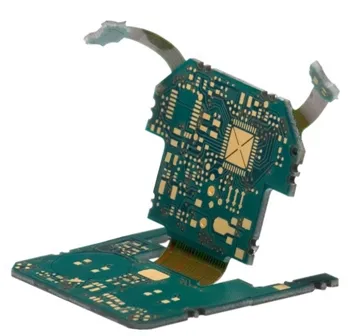设计刚柔结合PCB
什么是刚柔?

顾名思义,柔性印刷电路是指在柔性绝缘薄膜上印制的导电图案。刚柔结合电路是指同时包含柔性电路和刚性电路的印刷电路,如图所示。
柔性电路技术最初是为太空计划开发的,目的是为了节省空间和重量。如今,它因为不仅能节省空间和重量——使其成为移动电话和平板电脑等便携设备的理想选择——还可以降低包装复杂性、提高产品可靠性和降低成本而广受欢迎。
柔性电路通常分为两类使用场景:静态柔性电路和动态柔性电路。静态柔性电路(也称为用途A),是指在组装和使用过程中几乎不弯曲的电路。动态柔性电路(也称为用途B),是指设计用于频繁弯曲的电路,如磁盘驱动器头、打印机头,或作为笔记本电脑屏幕铰链的一部分。这种区分很重要,因为它会影响材料选择和构造方法。可以制作为刚柔结合的电路有许多层堆叠配置,每种配置都有其自身的电气、物理和成本优势。
机械刚柔设计
设计柔性或刚柔电路非常多是一种机电一体化的过程。设计任何PCB都是一个三维设计过程,但对于柔性或刚柔设计来说,三维要求更为重要。为什么?因为刚柔板可能需要附着在产品外壳的多个表面上,而附着和折叠过程通常在产品组装期间发生。提供一个有效的机电设计需要机械和电气工程团队之间的紧密且持续的合作。确认折叠板适合其外壳的传统方法是创建一个机械模型 - 通常称为纸娃娃剪裁。由于其本质,用这种方法很难达到所需的准确性和真实感。
 一个板子有两个刚性区域通过一个柔性区域在ECAD PCB编辑器和MCAD中连接。
一个板子有两个刚性区域通过一个柔性区域在ECAD PCB编辑器和MCAD中连接。
Altium正在通过CoDesigner来帮助解决这个挑战,这是一种先进的机械到电子设计接口技术。CoDesigner允许工程师直接在ECAD和MCAD设计软件内部来回传递板子形状和组件变化,介于ECAD和MCAD设计领域之间。
- Altium MCAD CoDesigner技术概述
- 技术参考,了解更多关于ECAD-MCAD 协同设计
- 了解更多关于将刚柔板设计转移到MCAD的信息
设计刚柔PCB
印刷电路板的设计是作为一个层叠在另一个之上的一系列层。对于传统的刚性印刷电路板,板形定义了X-Y平面上的电路板,而层的堆叠定义了Z平面上的电路板。X-Y板形在主PCB编辑窗口中定义,层在层堆叠管理器中配置。在刚性-柔性PCB中,成品印刷电路板中有不止一个区域或区域,每个区域可以使用不同的层集。
要设计一个刚性-柔性板,你需要:
- 启用所需的刚柔模式(层堆栈管理器,工具 » 功能 » 刚柔,或 工具 » 功能 » 刚柔(高级)命令)
- 为电路板的每个区域定义所需的子堆栈,并配置这些子堆栈在Z平面上如何对齐。
- 在X-Y平面上定义每个刚性和柔性区域的形状,并为每个区域分配正确的子堆栈。
启用刚柔设计
为了支持现代刚柔结合印刷电路板中存在的复杂结构,Z平面编辑器 - 层堆栈管理器,提供了不同的显示模式来编辑您的电路板结构。选择设计 » 层堆栈管理器命令来打开层堆栈管理器,在这里您可以启用所需的刚柔模式,并创建及对齐您刚柔设计中需要的子堆栈。 当层堆栈管理器打开时,它将显示当前的板层堆叠。对于新的PCB,这将是一个简单的双层板。要启用设计刚柔板所需的功能,请打开工具»功能子菜单,或点击功能按钮( ![]() )选择刚柔命令,或刚柔(高级)命令。
)选择刚柔命令,或刚柔(高级)命令。
 选择命令以启用所需的刚柔模式。
选择命令以启用所需的刚柔模式。
使用板区域
板区域是用来描述需要为其分配独特层堆栈的每个用户定义的板上区域的术语 - 这是刚柔相结合的PCB的标准要求。在下面的图片中,板形被划分为三个不同的板区域:上部的圆形区域、中间的细长条带区域和下部的圆形区域。

在板材规划模式下查看的刚柔板,注意板材形状已被划分为三个不同的板区,每个区域显示其区域名称和分配给它的层堆栈。
创建新板时,默认情况下它会有一个板区。如果板设计需要多个区域,那么你可以:
- 将单个板区切割成多个区域(标准刚柔模式或高级刚柔模式),或者
- 放置多个板区以构建整体形状(高级刚柔模式)。
板区在板规划模式中定义和编辑(查看菜单)。
处理弯曲线
在板规划模式中定义和编辑弯曲线(查看菜单)。
弯曲线的属性
弯曲线具有以下相互关联的属性:
- 弯曲角度(a)- 弯曲区域表面要弯曲的角度。
-
半径(
r)- 弯曲中心点距离弯曲表面的距离。 -
宽度(
w)- 给定半径和弯曲角度下将要弯曲的表面区域的宽度。
弯曲角度、半径和宽度之间的关系可以表示为:
-
w = a/360 * 2*Pi*r -
或用文字表达,
宽度 = 被弯曲的圆周的一部分 * 圆周长

浏览层叠区域和折弯线
在PCB面板的层叠区域模式下,其三个主要区域会变化,以反映以下内容(从上到下排序):
- 可用的层堆栈名称。
- 在电路板上定义的堆栈区域,或分配给选定层堆栈的区域。
- 选定堆栈区域中的弯曲线列表
在使用层堆栈区域模式的PCB面板时,通过查看»板规划模式菜单切换到板规划模式视图,或使用1快捷键。

电路板可以划分为不同的区域(堆叠区域),这些区域被分配了特定的层堆叠配置(层堆叠)。在电路板的柔性区域中定义了折叠区域(折弯线)。
当在PCB面板的层堆栈区域中选择了特定的层堆栈名称时,将使用层堆栈作为过滤范围应用过滤。因此,分配给该堆栈的任何板区域都将在面板的堆栈区域中列出。依次地,选定的堆栈区域中定义的任何弯曲线都将在弯曲线列表区域中列出。
在列表中双击一个堆叠区域(或在设计空间中双击板块区域本身)会打开板块区域对话框(标准刚柔结合模式)或属性面板的板块区域模式(高级刚柔结合模式)。使用此对话框/面板来重命名区域,将其分配给一个层堆叠,或锁定其3D属性。
在面板的弯曲线区域列表中双击一条弯曲线会打开弯曲线对话框,在该对话框中可以详细编辑线条的属性。
在3D中显示和折叠一个刚柔结合设计
PCB 编辑器包括一个强大的 3D 渲染引擎,它允许展示加载的电路板的高度逼真的三维表示。这个引擎还支持刚柔线路,当与 折叠状态 滑块结合使用时,在 PCB 面板中,它允许设计师检查他们的刚柔设计在平铺状态(未应用弯曲线设置)、完全折叠状态(应用了所有弯曲线设置)以及之间的任何状态。
要切换到 3D 显示模式,按 3 快捷键(按 2 返回到 2D 或 1 返回到板材规划模式)。电路板将以 3D 显示。如果组件足迹包括定义安装组件的 3D 体对象,这些也将被显示。在下面的图片中,你可以看到电路板包括一个电池和一个电池夹。
要应用所有的折弯线,请在设置为层堆区域模式时,滑动PCB面板中的折叠状态滑块,如下图所示。请注意,折弯是按照它们的序列号定义的顺序应用的。折弯线可以共享相同的序列号;这仅仅意味着当使用折叠状态滑块时,这些折弯将会同时被折叠。通过运行查看» 折叠/展开命令(或按5快捷键)也可以折叠/展开电路板。

使用折叠状态滑块(或5快捷键)按照它们的序列值(折叠索引)的顺序应用所有折弯线。
对刚柔设计的3D电影制作支持
刚柔设计的折叠能力也可以捕捉为3D电影。这样做非常简单,折叠序列期间不需要使用电影关键帧。
请参阅准备3D PCB视频页面,以获取制作3D电影的详细说明。作为基本指南:
- 将PCB编辑器切换到3D模式。
- 打开PCB 3D电影编辑器面板,并通过点击新建按钮创建一个新视频。然后在电影标题区域点击新创建的视频并给它一个合适的名字。
- 创建一个初始关键帧,显示电路板处于展开状态。
- 滑动折叠状态滑块,以显示硬挠设计在其折叠状态下,然后根据需要定位折叠后的电路板。
- 现在为这个视图创建第二个关键帧并设置时间。考虑您希望折叠硬挠设计所需的时间(持续时间设置);通常这会是几秒钟。
-
要检查视频是否正确捕捉到折叠过程,点击播放按钮(位于面板底部的播放器控制中)。

- 要生成电影文件,在输出作业文件中添加一个PCB 3D视频文档输出。记得在视频设置对话框中配置视频格式选项。
- 点击输出作业文件中的生成内容链接来创建电影文件。
下面的视频是使用这个过程创建的。它有上面描述的两个关键帧,加上最后添加的一个额外关键帧,用于保持最终位置一秒钟。  一个由三个关键帧创建的简单3D电影;折叠行为由弯曲线序列值定义。 ► 了解更多关于准备3D PCB视频 设计考虑因素
一个由三个关键帧创建的简单3D电影;折叠行为由弯曲线序列值定义。 ► 了解更多关于准备3D PCB视频 设计考虑因素
以下是设计刚性-柔性PCB时必须考虑的关键设计领域的总结:
- 导体布线 - 选择穿过柔性区域的路径的拐角样式很重要;避免尖锐的拐角;使用曲线以减少应力。
- 焊盘形状和面积 - 对于单面柔性电路,使用带有兔耳(锚定突刺)的圆角(泪滴形)。目的是用覆盖层捕获部分焊盘形状。
- 通孔 - 尽量避免在弯曲区域设置通孔,特别是在动态应用中。
- 覆盖层 - 避免应力集中点(暴露进入的轨迹);将覆盖层开口减少至250微米。
- 平面 - 如果可能,使用交叉阴刻。
- 错开长度 - 为避免层在弯曲时出现层间起皱(像书脊那样),通过将层的长度错开约1.5倍层厚度来实现。
- 服务环 - 使柔性区域稍微长一些,以帮助组装/拆卸并允许产品尺寸变化(额外的长度称为服务环)。
- 节约铜材 - 考虑柔性电路的面板化方式;调整设计以确保最佳材料使用可能更好。
- 面板化 - 根据材料的纹理方向定位柔性区域(沿着纹理弯曲)。
- 抗撕裂 - 圆角;在角落钻孔;在裂缝中钻孔;在角落留下金属。
- 布线 - 在双层板上交错布线以避免I形梁现象,并在弯曲区域加宽布线(这对于永久性弯曲尤其重要)。
- 静态弯曲比 - 设置弯曲半径与电路厚度的比率。理想情况下,多层电路的弯曲比率应至少为15:1。对于双面电路,最小比率应至少为10:1。对于单层电路,最小比率也应至少为5:1。对于动态应用,目标弯曲比率为20-40:1。
- 轧制退火铜更具延展性;镀铜不是柔性区域的最佳选择。
文件和绘图要求
典型的建议文件要求包括:
-
柔性PCB应按照IPC-6013,类别(您的要求)标准制造。
-
柔性PCB应构造以满足最低阻燃等级V-0(如有要求)。
-
柔性PCB应符合RoHS要求(如有要求)。
-
如果使用环氧材料,刚性材料应为IPC-4101/24规定的GFN。
-
如果使用聚酰亚胺材料,刚性材料应为IPC-4101/40规定的GIN。
-
柔性铜覆层材料应为IPC 4204/11(无粘合剂柔性铜覆介电材料)。
-
覆盖层材料应符合IPC 4203/1。
-
最大板厚不得超过(您的要求),适用于所有层压和电镀过程之后。这是在完成的电镀表面上测量的。
-
通过刚性板块部分的丙烯酸粘合剂厚度不得超过整体结构的10%。请参阅上述评论。
-
可使用袋材料以便于制造,并且必须在发货前从板材的柔性部分移除。
-
柔性部分的厚度应为(您的要求)。如果这个厚度不是关键的,不要添加此注释。
-
镀孔铜壁最小厚度应为(您的要求;推荐平均值为.001英寸),最小环形环宽度为(您的要求;推荐为.002)。
-
仅在板的刚性部分的两侧裸铜上覆盖绿色LPI防焊膜(如有要求)。所有暴露的金属将是(指定您的表面处理要求)。
-
如果需要,使用白色或黄色(最常见)非导电环氧墨水在板的两侧进行丝网印刷。
-
标记和识别要求。
-
电气测试要求。
-
包装和运输要求。
-
阻抗要求。
附加绘图详情
- 钻孔表,详细说明完成孔大小、相关公差以及是否镀层。
- 尺寸图,包括参考基准、关键尺寸、刚性至柔性接口、弯曲位置和方向标记。
- 如有需要,提供镶板细节。
- 构造和层次细节,详细说明每层使用的材料、厚度和铜重。
参考资料
柔性电路技术 - Joe Fjelstad
柔性电路设计指南 - Minco Products Inc
机械设计 网站:
